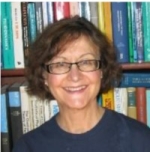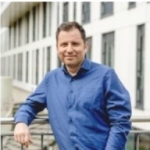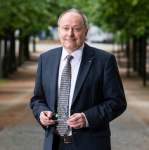Plenary and Semi-Plenary Speakers
Eva Andrei (room: Grand Auditorium)
Rutgers University, United States
Rutgers University, United States
Moiré materials: self-alignment, topology and quasi-crystals
Atomically thin crystals have transformed the way we think about materials. Their 2D structure makes it possible to control electronic properties by non-chemical means such as strain, electric fields, or stacking layers. In particular, the moiré pattern generated by wisting superposed atomic crystals produces moiré potentials leading to novel correlated and topological phases.
I will describe phenomena arising when three superposed atomic crystals produce not one, but two or more moiré patterns. Using STM and STS to study twisted bilayer graphene (TBG) superposed on an hBN substrate reveals a rich phase diagram comprised of periodic and aperiodic moiré crystals.
Mathematically, the special case of a 1:1 aligned commensurate moiré crystal, which is expected to display an anomalous quantum Hall effect, should be almost impossible to realize for rigid lattices.
Surprisingly, we find that it exists over a wide range of parameters, providing evidence of an unexpected relaxation mechanism favoring 1:1 moiré alignment. The aperiodic moiré crystals, which
characterized by sharp Bragg peaks and no translational symmetry, include a quasicrystal displaying a forbidden dodecagonal symmetry as well as a flat band which facilitates the emergence of
correlated electronic phases.
Jean-Marc Triscone (room: Grand Auditorium)
University of Geneve, Switzerland
www
Biography
University of Geneve, Switzerland
Jean-Marc Triscone is Professor of Physics in the Department of Quantum Matter Physics at the University of Geneva, leading a group working on correlated oxide heterostructures and oxide interface physics.
Jean-Marc Triscone obtained his PhD in 1987 in Geneva with Professor Øystein Fischer. In 1990-1991 and in 1995 he was a visiting scientist at Stanford University. Since 1996, he has been a full Professor in Geneva. Between 2001 and 2007 he has been Deputy-director of the National Center of Competence in Research MaNEP. Between July 2007 and June 2014, he was the Dean of the Faculty of sciences in Geneva. Since July 2015, he is a Vice-president of the University of Geneva.
With over 240 publications, over 16’000 citations and an h-index of 55, he is since 2006 a Fellow of the American Physical Society. He obtained in 2013 an ERC Synergy grant. He was awarded, with Harold Hwang and Jochen Mannhart, the 2014 European Physical Society Condensed Matter Division Europhysics Prize “For the discovery and investigation of electron liquids at oxide interfaces”.
Structural and electronic coupling at oxide interfaces
In this talk, I will discuss several interfacial couplings that can occur in oxide heterostructures. Polar discontinuities, for instance, can lead to 2-dimensional conduction between insulating materials and I will briefly discuss the case of the LaAlO3/SrTiO3 system. Structural and electronic coupling at oxide interfaces can also lead to interesting phenomena that we investigated in perovskite nickelates - well-known for their metal to insulator transition (MIT) and unique antiferromagnetic (AFM) ground state. There, I will show that there in an interfacial phase boundary cost between metallic and insulating regions that can be used to couple MIT’s or to turn a metal into an insulator. Finally I will present results on vanadatebased heterostructures where oxygen octahedra rotation coupling at orthorhombic interfaces leads to an “intermediate layer” that allows the orthorhombic structure to reorient its long-axis – a layer in unique strain conditions - that could become functional.
Andrea Cavalleri (room: Grand Auditorium)
Max Planck Institute, Hamburg, Germany
Max Planck Institute, Hamburg, Germany
New Physics Driven Quantum Materials
I will discuss how coherent electromagnetic radiation, when tuned to drive collective modes in quantum materials, can be used to induce unexpected dynamical phases. An illustrative set of examples will be discussed for the nonlinear control of the crystal lattice, which is used to induce magnetic order in paramagnetic materials, ferroelectricity in paraelectrics, non-equilibrium superconductivity at high temperatures and other dynamical phases. These studies open up new directions in fundamental research, but also expose a set of phenomena that will inevitably be encountered if one wishes to use quantum materials in ultra-high bit-rate applications.
N. Asger Mortensen (room: Grand Auditorium)
POLIMA – Center for Polariton-driven Light-Matter Interactions & Danish Institute for Advanced Study University of Southern Denmark
www
Biography
POLIMA – Center for Polariton-driven Light-Matter Interactions & Danish Institute for Advanced Study University of Southern Denmark
Mortensen is a full professor and the DNRF scientific director in the Center for Polariton-driven Light-Matter Interactions (POLIMA) and a Chair of Physics in the Danish Institute for Advanced Study, both at the University of Southern Denmark (SDU). Previously, he held a full professorship (faculty since 2004) at the Technical University of Denmark (DTU). He is a fellow of APS, OSA, SPIE, IOP, and European Academy of Sciences.
Mesoscopic electrodynamics, nonlocal response, and quantum corrections in surface-polariton systems
The electrodynamics of matter and optical phenomena are commonly explored within the framework of classical electrodynamics and semiclassical models for the interactions of light with matter. Materials are commonly assumed homogenous, and light-matter interactions are treated in an intuitive local manner. The plasmon-polaritons response of conductive materials is one such example, where the understanding of mesoscopic electrodynamics is, however, becoming increasingly important for both fundamental developments in quantum plasmonics and potential applications in emerging lightbased quantum technologies. The plenary talk will discuss recent examples of nonlocal effects and quantum corrections that emerge in surface-polaritonic systems, including metal surfaces, 2D materials, and combinations thereof.
Miguel Marques (room: Grand Auditorium)
Ruhr University Bochum, Germany
Ruhr University Bochum, Germany
Machine-learning assisted discovery and characterization of materials
We summarize our recent attempts to discover, characterize, and understand inorganic compounds using novel machine learning approaches. We start by motivating why the search for new materials is nowadays one of the most pressing technological problems. Then we summarize our recent work in using crystal-graph attention neural networks for the prediction of materials properties. To train these networks, we developed a dataset of over 4.5 million density-functional calculations with consistent calculation parameters. Combining the data and the newly developed networks we have already scanned thousands of structural prototypes spanning a space of several billion materials and identified tens of thousands of theoretically stable compounds. We then discuss how simple, interpretable machine learning approaches can be used to understand complex material properties, such as the transition temperature of superconductors. Finally, we speculate which role machine learning will have in the future of materials science.
Maia Vergniory (room: Grand Auditorium)
Max-Planck-Institute for Chemical Physics of Solids, Dresden, Germany & Donostia International Physics Center (DIPC), San Sebastián, Spain
Max-Planck-Institute for Chemical Physics of Solids, Dresden, Germany & Donostia International Physics Center (DIPC), San Sebastián, Spain
Towards Topological Diagnosis of Strongly Correlated Electron Systems
Topological quantum chemistry (TQC) framework has provided a complete description of the universal properties of all possible atomic band insulators in all space groups considering the crystalline unitary symmetries. It links the chemical and symmetry
structure of a given material with its topological properties. While this formalism filled the gap between the mathematical classification and the practical diagnosis of topological materials, an obvious limitation is that it only applies to weakly interacting
systems. It is an open question to which extent this formalism can be generalized to correlated systems that can exhibit symmetry protected topology like Kondo or Mott insulators. In this talk I will first introduce TQC and its application to correlated systems.
We will analyze the topology of Kondo using TQC insulators and compare it with many-body results. For Mott insulators we develop a general framework to address this outstanding question and illustrate its power in the case of Mott insulators. The concept of
Green's function Berry curvature -- which is frequency dependent -- is introduced. We apply this notion in a system that contains symmetry-protected nodes in its noninteracting bandstructure; strong correlations drive the system into a Mott insulating state, creating contours in frequency-momentum space where the Green's function vanishes. The Green's function Berry flux of such zeros is found to be quantized, and is as such direct probe of the system's topology. Our framework allows for a comprehensive search of strongly correlated topological materials with Green's function topology.
Franca Albertini (room: Small Auditorium)
IMEM-CNR, Parma, Italy
Magnetic shape memory Heuslers for energy and biomedical applications
Magnetic shape memory (MSM) Heuslers are an exciting class of ferroic materials, constantly opening new fields of research and application, arising from the strong interplay between thermal, mechanical and magnetic degrees of freedom. They have a great potential for energy related applications, such as solid state refrigeration, thermal and mechanical energy harvesting, remote actuation.
Their multifunctional properties arise from a reversible martensitic phase transformation associated with large changes in magnetization and/or magnetic order. In addition, their hierarchical twin-within-twin martensitic microstructure, and the strong spin-lattice coupling allow the control of their magnetic and functional properties from the atomic to the micro-scale, by tuning growth conditions and applying external fields.
In my talk I will report our recent results on NiMn-based MSM Heuslers, including micro/nanoscale materials (e.g. epitaxial thin films, patterned and free-standing structures, ball milled powders) obtained by different fabrication methods and I will deepen the effects of downscaling on the main properties, focusing on microstructure tuning and microstructure-related effects on the martensitic transformation. Besides discussing the obtained results in view of energy-related applications, I will highlight some new paths for the exploitation of MSM Heuslers in biomedical applications.
Andreas Wallraff (room: Grand Auditorium)
ETH Zürich, Switzerland
Quantum Science and Technology with Superconducting Circuits
Superconducting electronic circuits are ideally suited not only for studying the foundations of quantum physics but also for exploring applications in quantum information science. Since complex circuits containing hundreds or thousands of elements can be designed, fabricated, and operated with relative ease, superconducting circuits are one of the prime contenders forrealizing quantum computers, a goal vigorously pursued by both academic and industrial labs.
In this presentation, I will briefly introduce the basic concepts enabling the exploration of quantum physics with superconducting circuits [1] and comment on the state of the art of the field. After that, I will present two examples of recent research results from our lab at ETH Zurich, touching on both fundamental and applied aspects of quantum science with superconducting circuits. Using two superconducting qubits entangled over a distance of 30 meters we have recently succeeded in performing a loophole-free Bell test [2], a fundamental experiment performed for the first time with a macroscopic quantum system. Using a set of 17 superconducting qubits integrated on a single millimeter-scale device, we have recently realized repeated quantum error correction in the surface code [3]. This demonstrates an essential advance in the realization of fault-tolerant quantum computation, which requires the correction of errors occurring due to unavoidable decoherence and limited control accuracy.
This and similar demonstrations of repeated, fast, and high-performance quantum error correction support our understanding that fault-tolerant quantum computation will be practically realizable.
Pascale Launois (room: Small Auditorium)
University Paris-Saclay, France
University Paris-Saclay, France
The amazing properties of nano-confined water
A groundbreaking discovery in nanofluidics was the observation of the tremendously enhanced water permeability of carbon nanotubes, at the origin of an intensive research activity. Original experimental devices have been developed to measure flow through an individual nano-channel. In contrast to this "nano" approach, "macroscopic" approaches, i.e. studies of the properties of nano-confined fluids over billions of billions of nano-channels, provide additional and complementary information.
The original phase diagram of nanoconfined water, amazing structuration of water, its peculiar hydrogen bonding network, its specific vibrational and diffusion properties will be discussed based on the literature and on our studies.
Two different types of one-dimensional nanocontainers, respectively hydrophobic and hydrophilic, are considered: single-walled carbon nanotubes and single-walled imogolite nanotubes of nominal composition SiAl2O7H4 and GeAl2O7H4, with different diameters. We will present the results of a multi-technique approach, combining X-ray scattering, quasi-elastic and inelastic neutron scattering, infra-red spectroscopy and molecular dynamics simulations. We will also show that a flux measurement through an individual imogolite nanotube would lead to incorrect flux value.
Markus Munzenberg (room: Small Auditorium)
Greifswald University, Germany
Greifswald University, Germany
Ultrafast spintronics on attosecond time scales
Magnetization manipulation is an indispensable tool for both basic and applied research. I will discuss an actual overview on ultrafast magnetism and THz spintronics. The dynamics of the spin response depends on the energy transfer from the laser excited electrons to the spins within the first femtoseconds. Due to the non-equilibrium electron distribution in layered nanoscale spintronic devices, ultrafast spin currents are generated and contribute to the laser driven spin dynamics. Ultrafast laser-driven spin currents can be converted via the spin-Hall effect into a charge current burst that can even compete with state-of-art THz emitters. They allow to map topological spin structures, and their THz dynamics, with potentially with sub micron resolution as we recently demonstrated. We have also recently shown that attosecond lasers are breaking new frontiers and records towards the observation of coherent spin processes on ever shorter time scales, reaching Petaherz light frequency spintronics. Using light wave coherent charge transfer, driven by a few cycle laser pulse, I will report the first coherent attosecond magnetism in layered spintronic devices. These experiments, the fastest spin-dynamics observed experimentally, fit perfectly to the time scales for time resolved DFT, from theoretical sides revealing a coherent electron transfer at interfaces in operado. This opens up applications of coherent spin current processes.
Joaquín Fernández-Rossier (room: Grand Auditorium)
INL, Braga, Portugal
Flat bands, entanglement and fractionalization in bottom-up quantum matter
In this talk I will discuss two key problems in modern condensed matter physics. First, how to design artificial quantum matter endowed with non-trivial emergent properties such as flat-bands, entanglement and fractionalization, through the assembly of simpler building blocks such as nanographenes. Specifically, I will present the fascinating properties of spin-chains that have been already realized experimentally, such as the Haldane S=1 spin chain and the alternate exchange S=1/2 chain, as well as our predictions for nanographene two-dimensional crystals. Second, I will discuss how to probe the resulting emergent properties in these fascinating systems using scanning probes. In particular, I will show two techniques based on scanning tunnel microscopy (STM), inelastic electron tunnel spectroscopy (IETS-STM) and electron spin resonance (ESR-STM), provide information about the spin excitations, quantum entanglement and fractionalization in these structures. Finally will touch upon future prospects aimed at dynamically manipulating the quantum states in this class of artificial quantum materials.
Christiane Smith (room: Grand Auditorium)
Utrecht University, The Netherlands
Utrecht University, The Netherlands
Quantum fractals: from meta- to real materials
We know how electrons behave in 1,2,3 dimensions, but what about d=1.58? In this talk, I will first describe fractals, structures that may have a non-integer dimension. Then I will present experiments on electronic and photonic quantum simulators and explain how electrons and photons behave at fractal dimension. Finally, I will discuss the fractal-lattice Hubbard model and the topological properties of electrons in self-formed bismuth fractals on InSb.
Mário Silveirinha (room: Small Auditorium)
Instituto Superior Técnico, Lisboa, Portugal
Instituto Superior Técnico, Lisboa, Portugal
Distributed transistor response with chiral gain
Semiconductor transistors are key elements of electronic circuits as they enable, for example, the isolation and
amplification of voltage signals. While conventional transistors are point-type devices, it would be highly interesting to
realize a distributed transistor-type optical response in a bulk material.
In this talk, I will present an overview of the work of my group on distributed transistor- metamaterials. I will show that
the interplay of static electric bias and material nonlinearities may enable the design of non-Hermitian and non-reciprocal
transistor-like metamaterial responses. Moreover, it will be shown that natural low-symmetry materials may be the ideal
platforms to implement such a distributed-transistor response.
I will introduce a novel non-Hermitian electro-optic effect controlled by the Berry curvature dipole of a material.
Under a static electric bias, the electro-optic effect alters the optical conductivity of the material, breaking electromagnetic
reciprocity and yielding a dynamic non-Hermitian response similar to a transistor but distributed throughout the volume.
Notably, the active or dissipative nature of the material response is dependent on the handedness of the electromagnetic
wave. For waves polarized to the right, the response may be active (with optical gain), while the opposite handedness results
in a dissipative response. I will outline several exciting applications for transistor metamaterials and discuss how this class
of metamaterials has the potential to usher in a new era of terahertz devices that are both active and nonreciprocal.












